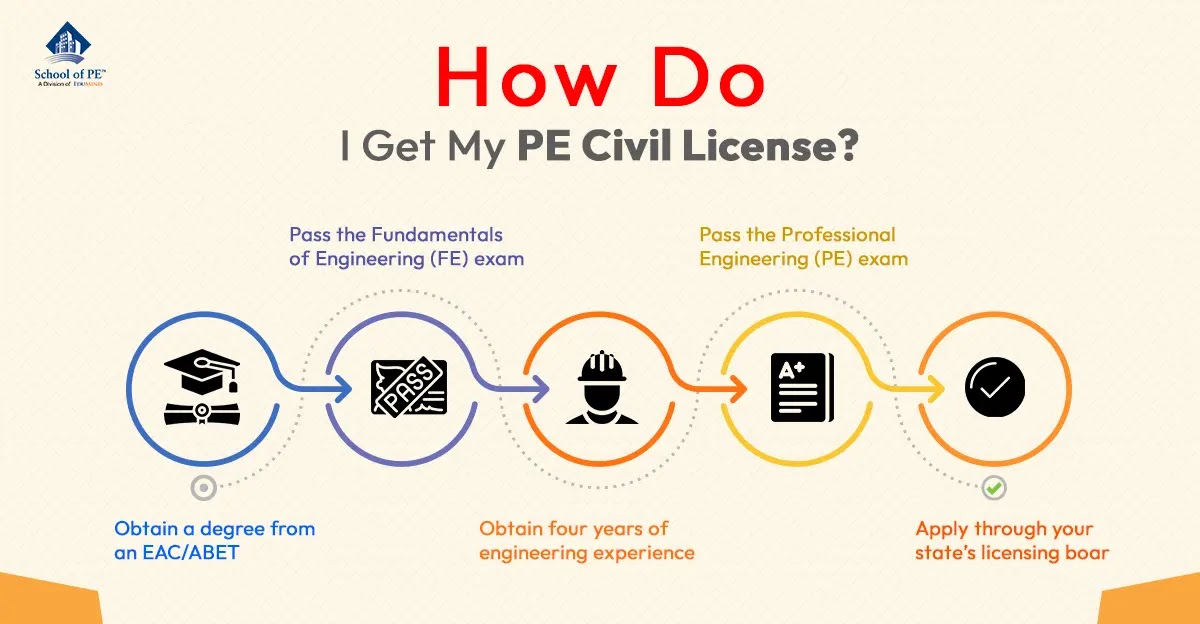Getting your Professional Engineering (PE) license can be one of the most rewarding achievements in your professional career. It is a testament to the dedication you have made to learning, studying, and understanding the field of engineering you are into the point where you have the authority to design and create new things safely, responsibly, and legally. Obtaining your license is a journey-many who embark on this journey begin in their college years but there are also other, lesser-known paths to licensure. Regardless of when you begin your journey to licensure in civil engineering, you will have to complete the following steps:
1. Obtain a degree from an EAC/ABET-accredited engineering program
You must obtain a degree from an accredited program in engineering to become a professional engineer. This can be in the form of a bachelor's degree, master's degree, or doctoral degree in many states, but most professionals obtain a bachelor's degree. If you are still looking for a program to attend, you can search accredited programs through the
ABET website. At this location, you can search for specific institutions or disciplines of engineering.
2. Pass the Fundamentals of Engineering (FE) exam
This is the first of two exams that are typically required to become a professional engineer in the United States. The FE exam is a test of knowledge across the entirety of your selected engineering discipline. It is 110 questions, six hours long, and includes a scheduled break. It is also entirely computer-based and must be taken at an NCEES-approved Pearson-VUE test center. The test's targeted age range consists of recent college graduates or students close to finishing their degree program. Taking this exam soon after graduating or toward the end of your program is a great idea since your college knowledge is still fresh in your mind. Many of the items on the FE exam are conceptual and may not be used daily in your actual profession moving forward, so delaying it only requires you to study harder later! Additionally, many colleges offer study courses for this exam and there is a plethora of study materials online, like those provided by
School of PE, you can find.
3. Obtain four years of engineering experience
The NCEES requires a minimum of four years of progressive and qualified engineering experience in order to obtain a license. Qualifying experience typical means under the supervision of another licensed professional engineer. While four years is the standard, some states allow exceptions. For example, some states may only require three years' worth of experience if you have obtained a master's or doctoral degree. This trend, however, seems to be fading in favor for the four-year experience, since many professional engineers can obtain a license in one state and then more quickly obtain a second license in another state. Because of this state-to-state licensing, many states are moving away from reduced experience levels.
4. Pass the Professional Engineering (PE) exam
If you have found this blog post, you are probably already aware of what the PE is. For civil engineering, the exam is an 80-question test that lasts for nine hours, including 50 minutes' worth of breaks. Beginning this year, the civil PE will be a computer-based exam-like the FE-and can only be taken at NCEES-approved VUE testing centers. This exam is much more daunting than the FE exam, as it covers the general practice of civil engineering as well as specific questions that are based on your chosen sub-discipline, questions that are typically harder and more precise. Passing this exam requires lots of studying and preparing by utilizing study resources and becoming familiar with the test format.
5. Apply through your state's licensing board
The last step is to formally apply for licensure once you have completed the previous four steps. Each state within the United States has its own licensing board through which you must apply; in fact, you can find a
comprehensive list of each state's licensing board on the NCEES website. There is typically an application fee and other items required such as references and documented experience depending on the state of application.
And there you have it! Once you have finished all five of these steps, you will be ready to sign and seal your own civil engineering designs and conquer the world! Professional licensure is one of the most monumental milestones in your professional career and opens you up to a world of possibilities! If you are wondering whether you should become a licensed engineer or not, check out my last blog post for my thoughts on the benefits of becoming licensed, found
here!
About the Author: John Holmes
John Holmes is a professional civil engineer who works on airport infrastructure including runways, taxiways, aprons, and terminals. He was born and raised in North Carolina and still lives there where he obtained both his BSCE and MCE from North Carolina State University. In his spare times, John loves spending time with his wife and son. He also enjoys tending to his growing farm and garden, including chickens, turkeys, and goats.

No comments :
Post a Comment